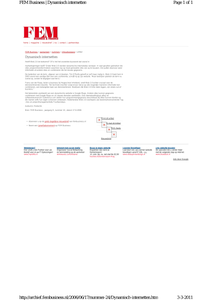On the internet we see a continuously growing generation of web applications enabling anyone to create and publish online content in a simple way, to link content and to share it with others: wellknown instances include MySpace, Facebook, YouTube, Flickr, Wikipedia and Google Earth. The internet has become a social software platform sailing under the Web 2.0 flag, creating revolutionary changes along the way: the individual, the end-user, comes first and can benefit optimally from an environment which has the following keywords: radically user-oriented, decentralized, collective and massive. ‘An environment in which each participant not only listens, but can also make his own voice heard’: the Social Web. This document describes a brief exploration of this Social Web and intends to gain insight in possible fundamental changes this phenomenon is causing or might cause in our society. Particular attention will be paid to the impact of the Social Web on learning and education. For how do two apparently contrary developments touch and overlap? On the one side we have the rapid growth of technologies bringing individuals together to communicate, collaborate, have fun and acquire knowledge (social software). And on the other hand we have the just conviction within the world of education that young people should not only acquire knowledge and information, but should also have all kinds of skills and experience in order to meet social and technological changes deliberately, and prepare for a life long of learning.
DOCUMENT

In dit artikel wordt ingegaan op de snel veranderende digitale wereld. Want het stof rondom de term 'web 2.0' mag zo langzamerhand dan wel opgetrokken zijn, vragen blijven er genoeg. Welke impact hebben al die elkaar steeds sneller opvolgende ontwikkelingen nu eigenlijk op bibliotheken? In hoeverre dringt web 2.0 al door in de organisatie, in de werkprocessen, de klantbenadering en in de digitale bibliotheek? Vergt het wellicht ook een andere attitude van de bibliotheekmanager? En welke gevolgen heeft web 2.0 voor het functieprofiel van de informatiespecialist? Vragen als deze en nog meer, worden in dit artikel verder uitgediept.
DOCUMENT

Social media zijn momenteel het gesprek van de dag. In slechts enkele jaren tijd hebben social media sites als YouTube, Facebook en LinkedIn een miljoenenpubliek aan zich gebonden. En het aantal consumenten en bedrijven dat gebruik maakt van deze online platformen groeit nog steeds sterk. Hoewel er dagelijks nieuwe cijfers verschijnen over het gebruik van social media is er vooralsnog weinig bekend over de adoptie van social media door bedrijven. Middels dit boek willen de onderzoekers van het lectoraat Online Ondernemen van de Hogeschool van Amsterdam een bijdrage leveren aan het opvullen van deze kennisleemte door het social media gebruik binnen de detailhandel in Nederland in kaart te brengen. Het boek bevat de resultaten van een onderzoek naar gebruik van de social media sites Hyves, Facebook, LinkedIn, YouTube, weblogs, Twitter en fora door (web)winkels en consumenten in Nederland. Welke social media sites worden veel en welke weinig gebruikt door (web)winkels en consumenten in Nederland? Wat zijn de kenmerken van de (web)winkels en consumenten die voorop lopen en achterblijven in het gebruik van social media platformen? In hoeverre zijn Nederlanders geïnteresseerd in het volgen van commerciële bedrijven via social media? Hoeveel volgers hebben (web)winkels op Hyves, Facebook, LinkedIn, YouTube en Twitter? Op deze en andere vragen over het gebruik van social media in de detailhandel in Nederland wordt in dit boek antwoord gegeven.
DOCUMENT

On the internet we enjoy a continuously growing generation of web applications enabling anyone to create and publish online content in a simple way, to link content and to share it with others. The internet has become a social software platform sailing under the Web 2.0 flag, creating revolutionary changes along the way: the individual, the end-user, comes first and can benefit optimally from an environment which has the following keywords: radically user-oriented, de-centralized, collective and massive. An environment in which each participant not only listens, but can also make his own voice heard: the Social Web.
DOCUMENT

Wereldwijd onderzoek: Hoe gebruiken nieuwsmedia social media? Jongeren lezen geen krant meer, ze kijken op hun smartphone die ze altijd bij de hand hebben. Binnen het lectoraat social media en reputatiemanagement van NHL hogeschool te Leeuwarden heeft een groep internationale studenten in 12 landen onderzoek gedaan. Hierbij hebben ze meer dan 150 social media sites bestudeerd van nieuws media. De resultaten maken deel uit van een internationaal onderzoek van NHL Hogeschool en Haaga Helia University. De onderzoeksvraag was: Wat speelt zich af in de nieuwsmedia? Persbureaus kunnen het overzicht gebruiken om hun social media te optimaliseren. En voor ieder die journalistiek een warm hart toedraagt is het interessante informatie over de nieuwsmedia in een overgangssituatie (2nd edition)
DOCUMENT

This paper will describe the rationale and findings from a multinational study of online uses and gratifications conducted in the United States, Korea, and the Netherlands in spring 2003. A survey research method of study was conducted using a questionnaire developed in three languages and was presented to approximately 400 respondents in each country via the Web. Web uses and gratifications were analyzed cross-nationally in a comparative fashion and focused on the perceived involvement in different types of on-line communities. Findings indicate that demographic characteristics, cultural values, and Internet connection type emerged as critical factors that explain why the same technology is adopted differently. The analyses identified seven major gratifications sought by users in each country: social support, surveillance & advice, learning, entertainment, escape, fame & aesthetic, and respect. Although the Internet is a global medium, in general, web use is more local and regional. Evidence of media use and cultural values reported by country and online community supports the hypothesis of a technological convergence between societies, not a cultural convergence.
DOCUMENT
Longitudinal criminological studies greatly improved our understanding of the longitudinal patterns of criminality. These studies, however, focused almost exclusively on traditional types of offending and it is therefore unclear whether results are generalizable to online types of offending. This study attempted to identify the developmental trajectories of active hackers who perform web defacements. The data for this study consisted of 2,745,311 attacks performed by 66,553 hackers and reported to Zone-H between January 2010 and March 2017. Semi-parametric group-based trajectory models were used to distinguish six different groups of hackers based on the timing and frequency of their defacements. The results demonstrated some common relationships to traditional types of crime, as a small population of defacers accounted for the majority of defacements against websites. Additionally, the methods and targeting practices of defacers differed based on the frequency with which they performed defacements generally.
DOCUMENT

Over the past 15 years the Web has transformed the ways in which we search for information and use it. In more recent years, we have seen the emergence of a new array of innovative tools that collectively go under the name of 'Web 2.0', in which the information user is also increasingly an information producer (i.e., prosumer), by sharing or creating content. The success of Web 2.0 tools for personal use is only partially replicated in the professional sphere and, particularly, in the academic environment in relation with research and teaching. To date, very few studies have explored the level of adoption of Web 2.0 among academic researchers in their research and teaching activity. It is not known in what way how and how much Web 2.0 is currently used within research communities, and we are not aware of the drivers and the drawbacks of the use of Web 2.0 tools in academia, where the majority of people is focused either on research or on teaching activities. To analyse these issues, i.e. the combined adoption of Web 2.0 tools in teaching and research, the authors carried out a survey among teaching and researching staff of the University of Breda in The Netherlands. This country was chosen mainly because it is on the cutting edge as far as innovation is concerned. An important driver in choosing the Breda University's academic community was the fact that one of the two authors of this survey works as senior researcher at this university. The purpose of our survey was to explore the level of adoption of Web 2.0 tools among the academic communities. We were interested in investigating how they were using these tools in the creation of scientific knowledge both in their research and teaching activity. We were also interested in analysing differences in the level of adoption of Web 2.0 tools with regard to researchers' position, age, gender, and research field. Finally, in our study we explored the issue of peer reviewing in the Web 2.0 setting. In particular, we investigated whether social peer review is regarded by researchers as a viable alternative to the current closed peer review system (single-blind or double blind). We approached about 60 staff members, but only 12 faculty members completed the survey fully. This means that our results can only be regarded as exploratory, but we still believe that they represent a complementary perspective with respect to previous studies.
LINK
Businesses today are facing ever greater competition. Products and services need to be delivered faster, more efficiently and at lower price. Companies are forced to supply customised products: demand-oriented production. In order to meet this changing demand, companies have to subcontract and collaborate. An efficient web service system that defines tasks and roles is indispensable for achieving this. The spiders in the web are people. People have a number of tools to hand that enable them to design or adapt the process-oriented organisation. In this regard, people have access to an ever increasing number of standardised process objects (web services) that are available via the Internet.
DOCUMENT

Heeft Web 2.0 de toekomst? Of is het het zoveelste buzzword dat vooral in marketingkringen leeft? Onder Web 2.0 worden dynamische internetsites verstaan. In veel gevallen gebruiken die sites programmeertechnieken waarmee rap op maat gemaakte sites zijn op te bouwen. Die putten daarvoor weer informatie uit andere sites en combineren die tot nieuwe gegevens.
DOCUMENT
